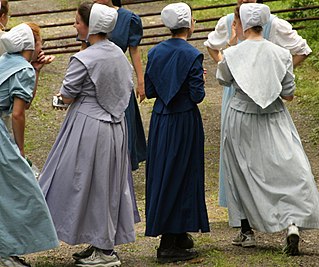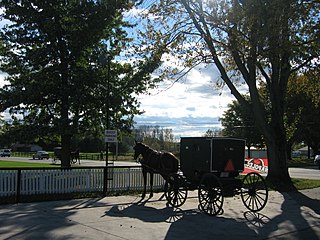Related Research Articles

Mennonites are a group of Anabaptist Christian church communities tracing their roots to the Radical Reformation. The name is derived from that of one of the early prominent leaders of the Anabaptist movement, Menno Simons (1496–1561). Through his writings about Reformed Christianity during the Radical Reformation, Simons articulated and formalized the teachings of earlier Swiss Anabaptist founders as well as early teachings of the Mennonites founded on the belief in both the mission and ministry of Jesus. The original Anabaptist followers had held such beliefs with great conviction, despite persecution by various Roman Catholic and Mainline Protestant states. Formal Mennonite beliefs were codified in the Dordrecht Confession of Faith (1632), which affirmed "the baptism of believers only, the washing of the feet as a symbol of servanthood, church discipline, the shunning of the excommunicated, the non-swearing of oaths, marriage within the same church", strict pacifistic physical nonresistance, anti-Catholicism and in general, more emphasis on "true Christianity" involving "being Christian and obeying Christ" as they interpret it from the Holy Bible.

The Old Order River Brethren are a River Brethren denomination of Anabaptist Christianity with roots in the Radical Pietist movement. As their name indicates, they are Old Order Anabaptists.
Old Order Mennonites form a branch of the Mennonite tradition. Old Order are those Mennonite groups of Swiss German and south German heritage who practice a lifestyle without some elements of modern technology, still drive a horse and buggy rather than cars, wear very conservative and modest dress, and have retained the old forms of worship, baptism and communion.
The New Order Amish are a subgroup of Amish that split away from the Old Order Amish in the 1960s for a variety of reasons, which included a desire for "clean" youth courting standards, meaning they do not condone the practice of bundling during courtship. Tobacco and alcohol are also not allowed. They also wished to incorporate more evangelical elements into the church, including Sunday school and mission work. Some scholars see the group best characterized as a subgroup of Old Order Amish, despite the name.
Amish Mennonites came into existence through reform movements among North American Amish mainly between 1862 and 1878. These Amish moved away from the old Amish traditions and drew near to the Mennonites, becoming Mennonites of Amish origin. Over the decades, most Amish Mennonites groups removed the word "Amish" from the name of their congregations or merged with Mennonite groups.

The Groffdale Conference Mennonite Church, also called Wenger Mennonites, is the largest Old Order Mennonite group to use horse-drawn carriages for transportation. Along with the automobile, they reject many modern conveniences, while allowing electricity in their homes and steel-wheeled tractors to till the fields. Initially concentrated in eastern Lancaster County, Pennsylvania, their numbers had grown to 22,305 people resided in eight other states as of 2015. They share the pulpit with the Ontario Mennonite Conference but have some differences in Ordnung.

The Amish, formally the Old Order Amish, are an ethnoreligious group with Swiss German and Alsatian origins. Consisting of several Anabaptist Christian church fellowships, they are closely related to Mennonites, a separate Anabaptist denomination. The Amish are known for simple living, plain dress, Christian pacifism, and slowness to adopt many conveniences of modern technology, with a view neither to interrupt family time, nor replace face-to-face conversations whenever possible, and a view to maintain self-sufficiency. The Amish value rural life, manual labor, humility and Gelassenheit. As they rarely accept converts, maintain a separate language and culture from surrounding populations, and hold their faith in common, they have been described by scholars as an ethnoreligious group, combining features of an ethnicity and a denomination.
Conservative Mennonites include numerous Conservative Anabaptist groups that identify with the theologically conservative element among Mennonite Anabaptist Christian fellowships, but who are not Old Order groups or mainline denominations.
The Orthodox Mennonites, also called Wellesley Orthodox Mennonites and Huron Orthodox Mennonites, are two groups of traditional Old Order Mennonites in Canada and the US with about 650 baptized members. Even though plain to a very high degree and primitivist concerning technology, they are rather intentionalist minded than ultra traditional. Since 1999 they were joined by several other Old Order Mennonite communities.

The Weaverland Conference, also called Horning Church or Black-bumper Mennonites, is a Christian denomination of Old Order Mennonites who use cars.
The Noah Hoover Mennonites, called "Old Order Mennonite Church (Hoover)" by the Mennonite World Conference, and sometimes called "Scottsville Mennonites”, are a group of very plain Old Order Mennonites that originally came from the Stauffer Mennonites and later merged with several other groups. Today it is seen as an independent branch of Old Order Mennonites. The group differs from other Old Order Mennonites by having settlements outside the US and Canada and by attracting new members from other groups on a larger scale. They have more restrictions on modern technology than all other Old Order Mennonite groups. They are rather intentionalist minded than ultra traditional.
Stephen Scott was an American writer on Anabaptist subjects, especially on Old Order and Conservative Mennonite groups.
The Ohio-Indiana Mennonite Conference, also called Wisler Mennonites, is an Old Order Mennonite church body, whose Ordnung allows the ownership and private use of cars. They are quite similar to the Weaverland Old Order Mennonite Conference.
The Virginia Old Order Mennonite Conference, also called Cline Mennonites or Cline-Showalter group, is an Old Order Mennonite group to use horse-drawn carriages for transportation. It separated from the Virginia Mennonite Conference in 1901. The members of the group speak English only, unlike almost all other horse and buggy Old Order Mennonite groups, who speak Pennsylvania German as their first language. In recent years the group sometimes uses the name "Riverdale Old Order Mennonite Church".
The John Dan Wenger Mennonites are an Anabaptist Christian denomination that belongs to the Old Order Mennonites. They use horse and buggy transportation and are mainly located in Virginia. Under the leadership of Bishop John Dan Wenger, they separated from the Virginia Old Order Mennonite Conference in either 1952 or 1953.
A Seeker is a person likely to join an Old Order Anabaptist community, like the Amish, the Old Order Mennonites, the Hutterites, the Old Order Schwarzenau Brethren or the Old Order River Brethren. Among the 500,000 members of such communities in the United States there are only an estimated 1,200 to 1,300 outsiders who have joined them.

The Byler Amish, also called Alt Gemee, are a small conservative subgroup of the Amish. They are known for the yellow color of their buggies, which earned them the nickname "yellow-toppers" and for wearing only one suspender. They are the oldest Old Order Amish affiliation that separated for doctrinal and not for geographical reasons.

Old Order Anabaptism encompasses those groups which have preserved the old ways of Anabaptist Christian religion and lifestyle.
Charity Ministries, also called Charity Christian Fellowship, is a Conservative Anabaptist network of churches that was formed in 1982 in Lancaster County, Pennsylvania.

The Kauffman Amish Mennonites, also called Sleeping Preacher Churches or Tampico Amish Mennonite Churches, are a plain, car-driving branch of the Amish Mennonites whose tradition goes back to John D. Kauffman (1847–1913) and Noah Troyer (1831–1886) who preached while being in a state of trance and who were seen as "sleeping preachers".
References
- ↑ Donald B. Kraybill (2010). Concise Encyclopedia of Amish, Brethren, Hurtterites and Mennonites. Johns Hopkins University Press. p. 252.
- ↑ Stephen Scott (1996). An Introduction to Old Order: and Conservative Mennonite Groups. Good Books, Intercourse, PA. p. 30.
- ↑ Stephen Scott (1996). An Introduction to Old Order: and Conservative Mennonite Groups. Good Books, Intercourse, PA. pp. 18–20.
- ↑ "Old Order Mennonites, church groups find ways to adapt to COVID-19". Flamborough Review. 27 March 2020. Retrieved 6 December 2020.
- ↑ "Public health intervenes to limit COVID-19 surge among old order Mennonites". Waterloo Region Record. 30 November 2020. Retrieved 6 December 2020.
Infection rates in rural Mennonite areas are the highest in the region ... "Unfortunately, we have encountered insufficient co-operation among a number of individuals with public health requirements"
- ↑ "Critical threat to Old Order Mennonite community forced order by Public Health". Guelph Today. 15 November 2020. Retrieved 6 December 2020.
it is in many ways, an option of last resort and it's something we only do when we think we have a critical threat to the community's safety and we need immediate action
- ↑ Old Order Mennonites at Global Anabaptist Mennonite Encyclopedia Online.
- ↑ Stephen Scott: An Introduction to Old Order: and Conservative Mennonite Groups, page 30.
- ↑ Donald B. Kraybill (2010). Concise Encyclopedia of Amish, Brethren, Hutterites and Mennonites. Johns Hopkins University Press. p. 252.
- ↑ "Old Order Mennonites" (PDF). groups.etown.edu. Retrieved 15 September 2023.